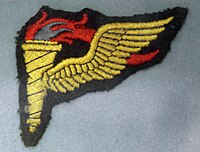Pathfinder (military)

Pathfinding in the military is like playing a game of "follow the leader". Just like how you follow your parents when you go on a walk or a hike, soldiers who are trained as pathfinders are the ones who lead other soldiers through unfamiliar territory. But instead of simply walking on a path or a trail, they create their own path through dense forests, rocky mountains or swampy terrain.
Imagine you are walking through a thick forest and there are no clear paths to follow. Suddenly, a pathfinder appears and starts making a trail by clearing away bushes and branches, cutting down trees and marking the path with signs. Your job as a soldier would be to follow the pathfinder closely, copying every move they make, looking out for any obstacles along the way and making sure you are always on the right track.
Pathfinders use special techniques and tools to navigate through the challenging terrain, such as maps, compasses, GPS devices and sometimes even helicopters or planes to survey the area from above. In addition to creating paths, pathfinders also provide information on potential dangers, such as steep cliff edges or quicksand, and suggest the best route for soldiers to take.
Pathfinding is critical in a military operation, especially during times of war or conflict when soldiers need to move through unfamiliar and dangerous territories. Without pathfinders, it would be much harder for the military to navigate through these areas and accomplish their missions successfully.
Imagine you are walking through a thick forest and there are no clear paths to follow. Suddenly, a pathfinder appears and starts making a trail by clearing away bushes and branches, cutting down trees and marking the path with signs. Your job as a soldier would be to follow the pathfinder closely, copying every move they make, looking out for any obstacles along the way and making sure you are always on the right track.
Pathfinders use special techniques and tools to navigate through the challenging terrain, such as maps, compasses, GPS devices and sometimes even helicopters or planes to survey the area from above. In addition to creating paths, pathfinders also provide information on potential dangers, such as steep cliff edges or quicksand, and suggest the best route for soldiers to take.
Pathfinding is critical in a military operation, especially during times of war or conflict when soldiers need to move through unfamiliar and dangerous territories. Without pathfinders, it would be much harder for the military to navigate through these areas and accomplish their missions successfully.
Related topics others have asked about:
